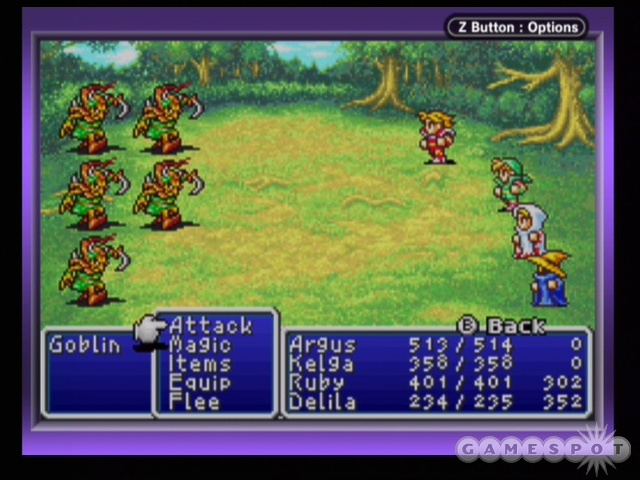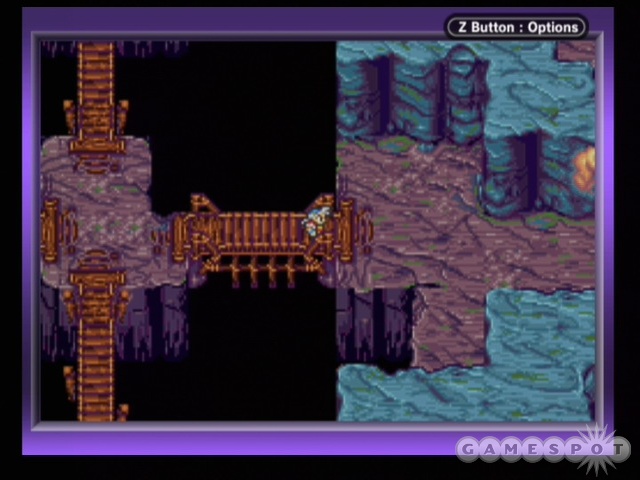First remade for the Japanese-produced Bandai WonderSwan Color handheld, Final Fantasy I and II both also enjoyed a combined showing on the PlayStation as Final Fantasy Origins. Now, the same versions of these games have finally made their ways onto Nintendo's Game Boy Advance, with the subtitle Dawn of Souls. While the games themselves are pretty much unchanged graphically, the GBA versions have some additions in the ways of bonus dungeons (in Final Fantasy I) and an extended storyline (in Final Fantasy II). The compilation here offers a lot of role-playing bang for your buck, and though each game shows its age a bit, the combined package is still worthwhile for old-school RPG fans and patient neophytes.

The gameplay in Dawn of Souls hearkens back to an earlier era in which your success at role-playing games was determined by the amount of time you spent leveling up your characters. And if you're the kind of person that enjoys plowing into incessant random battles and obliterating countless goblins and other assorted creatures in rapid succession to achieve your goals, then this package will give you that in spades. Leveling in Final Fantasy I tends to be quite brisk, and the overall difficulty of the game seems to have been tweaked down a bit, so the game is fairly straightforward. Final Fantasy II uses a different system of character advancement, so instead of collecting experience points toward a new level, your characters will have their stats augmented depending on their actions in battle. For example, a character that gets hit repeatedly by foes will have his or her maximum hit points go up, whereas a character that uses spells often will see his or her spell effectiveness increase. Similarly, a character that attacks often will see his or her strength and weapon proficiencies increase, and so on. This means that overall you'll need to pay a bit more attention to how your characters are developing in Final Fantasy II. However, they'll still progress fairly evenly just by fighting repeated successive battles (and they're in ready supply).
Battle works much the same in both games, so basically, a group of up to four characters faces off against single or multiple enemies, and often, all you have to do is just quickly ask all your party members to hit something. Much like in Final Fantasy Origins (and unlike the original NES versions of these games), if a selected monster dies before a party member's turn to hit it, that character will simply attack another foe at random, instead of wasting a turn. Random battles in these games tend to progress about as quickly as your little thumb can manage to press the A button for attacks or spells, so at least the monster throngs you come across will be out of your way quickly. It's a satisfying, if not mentally taxing, battle system, but these games were always about your ability to endure against monster armies rather than deep strategy. So the formula still holds its own, particularly for RPG fans who relish battling their characters to the highest levels.
The characters are for the most part undeveloped, at least in the first game, in which you select a group of four character classes to become the four crystal heroes who are out to save the world from destruction. There's a storyline in the second game that revolves around a group of three youths, orphaned by a terrible war, that search for a way to end the conflict. Here you'll meet some notable personalities and see the character of the Final Fantasy series start to emerge a bit. In addition to its standard storyline, Final Fantasy II has an extra playable scenario that becomes available after you finish the game. This scenario pits a group of deceased characters in the afterlife against even more foes. Final Fantasy I, likewise, has some extra content in the form of four new dungeons that are unlocked as you defeat the four Fiends of Chaos. Each dungeon is of random design and is filled to the brim with enemies and treasure. Monsters from later Final Fantasy games also make appearances in these dungeons, so the hardcore should enjoy ferreting them out. If you defeat the fiend at the end of the dungeon, you'll get to keep a number of treasures that come in the form of powerful items, which are sure to make your way through the game much easier.
Graphically, not too much has happened to these WonderSwan ports. All the environments and character sprites are clean and distinct, though the latter tend to be tiny and only very simply detailed. The various monsters and their color-swapped cousins that you'll meet represent a good cross section of baddies, from spiders and sharks to giant eyeballs, evil horses, enemy soldiers, and everything in between. The game even has a bestiary that you can use to check out all the monsters--from either Final Fantasy--that you've run across. Otherwise, the game is a good port, though without an excess of graphical detail. Simple flowing landscapes, quaint towns and villages, various themed dungeons, and a bit of animated flash with magic spells rounds out the visuals.

Fans of Final Fantasy will be humming along to their favorite tunes in no time at all, because the sounds of both games have mostly not changed from the originals, barring a theme or two. The music is still dominated by simple synth, particularly in the first game, but the tunes themselves have a nice richness to them, and the musical score holds up well after all these years.
Final Fantasy fans who might have missed playing Final Fantasy Origins on the PlayStation will find Dawn of Souls to be a nice compilation of two old favorites to take on the road. If you've played Origins, you've already played these games, though the bonus content on offer represents some nice extra material for the truly hardcore. While Final Fantasy I and II are each getting a little long in the tooth, each remains a classic, living representation of the original RPG style.